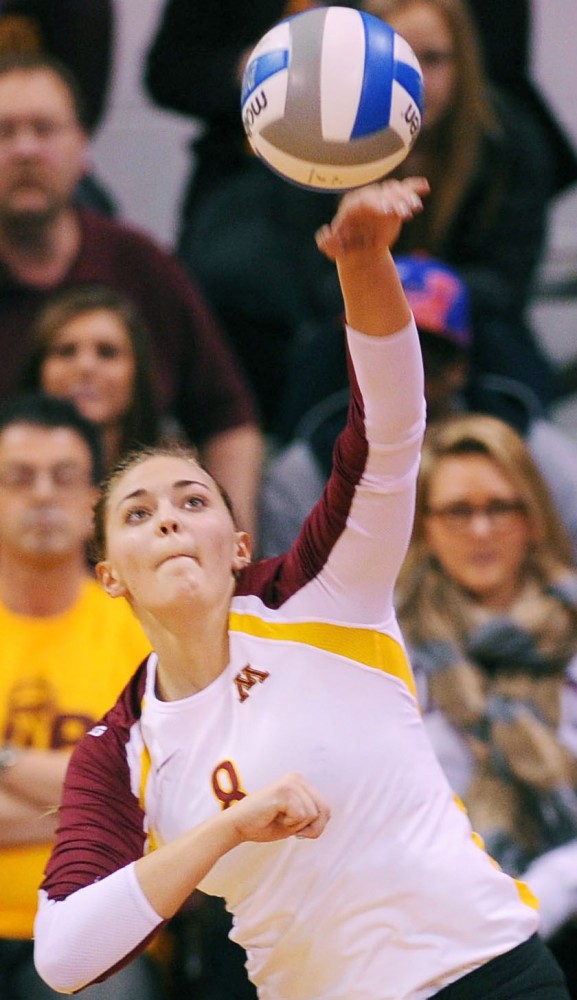Senior outside hitter Katherine Harms insists she hasn’t done anything different this year.
She hasn’t added extra workouts or a new diet to her daily routine. She still enjoys frequent trips to Qdoba. Yet her volleyball game has improved dramatically in her senior season with the Gophers.
“Just having this final year, I think everything finally just clicked,” Harms said.
In 2011, Harms finished third in kills for the Gophers with 305, averaging 2.82 kills per set with a .193 hitting percentage.
This year, she has improved in nearly every statistical category. She’s played in every set leading up to this weekend’s NCAA regional at Purdue, and she leads the team with 484 kills, averaging 4.10 per set with a .317 hitting percentage.
With Harms’ improved play has come recognition she hadn’t experienced before in her career.
She earned three Big Ten Player of the Week awards this season and made the All-Big Ten and All-Region teams.
“I always knew she was going to be able to do it,” junior middle blocker Tori Dixon said. “But it was a matter of just when is it going to happen.”
Figuring it out
Harms’ senior season has been remarkable and reliable. But she wasn’t always as consistent.
Harms said she struggled with her technique when she started playing club volleyball at age 14.
“I kind of had to hit the ball up to get it over the net,” Harms said. “[My coach] was a little concerned that I was never going to figure it out.”
But once she overcame her “awkward” phase, she started to develop her game more.
Harms said that when she was 15, Minnesota sent her a letter showing interest in recruiting her.
“Then it kind of clicked,” Harms said. “Like, ‘Oh, I might actually be kind of good at this sport. I might see where this is going.’”
Harms said she looked at a few other schools, but her father Dana Harms said Minnesota was the only place his daughter wanted to play.
“We even had the conversation with Katherine that you could come to the University and never get on the court. Was that OK?” Dana Harms said. “And her response was, ‘Yeah, that’s OK.’”
Katherine Harms saw playing time right away and earned more as she improved her consistency. And she wasn’t afraid to compete for it, like she did her sophomore year when Dixon played the same position.
“She kind of scared me a little bit,” Dixon said. “She was kind of like the person I was competing with every day in practice. So things might have gotten a little feisty at times.”
Former head coach Mike Hebert said Harms struggled to be consistent when he coached her in her first two seasons.
“I don’t think she was ever fully committed to the game the way she is now. … She just didn’t have it figured out yet,” Hebert said. “Those two dangling wires — they touch every once in a while. And they did for Katherine this fall.”
Get out of Harms’ way
Harms, recognizable by her blonde, multicolor-streaked hair, attributed her turnaround this season mainly to a change in her mentality — and knowing this was her last chance with the Gophers.
“Part of me felt like maybe I had cut myself short a little bit the first couple of years,” Harms said.
Hebert said Harms’ change was a cumulative process. Dana Harms also said his daughter didn’t improve overnight.
“She’s put in a lot of hard work,” he said. “Once she just kind of trusted the process, trusted herself and just let things happen … the success just built.”
While Katherine Harms’ outlook may have changed, she also had to tweak her style of play. Throughout the season, she has worked on finding different ways to kill the ball.
Her new versatility became especially important when opponents started imposing double blocks against her.
“[I am] finally learning better ways — more efficient ways — to do things,” Harms said, “instead of being that little freshman who thought she could hit it harder than anyone else and hopefully that would work.”
Head coach Hugh McCutcheon said he challenged Harms this year to not only adjust her attack but also to improve her blocking, defense and serving. McCutcheon said she’s delivered in every category.
Harms introduced a jump-spin serve this season that has helped her earn 40 aces, second-best on the team. She has also tallied 294 digs, which is tied for second.
“She’s certainly been a big part of our success,” McCutcheon said. “She’s certainly seen the highest number of swings, and I think that’s appropriate.”
Hebert said Harms creates obstacles for other teams in addition to helping her own team.
“To have a player who can score the way she can on the right side, it presents a real dilemma for the opponent,” Hebert said. “It’s not just kills. It’s the fact that she’s such a threat.”
Dixon, Harms’ best friend, said Harms has matured both on and off the court. The pair exemplifies this maturity when they shake hands during the starting lineup announcements instead of high-fiving like the rest of the team.
“It’s our little handshake because we’re classy all the time,” Dixon said. “We feel like classy people shake hands, and we don’t high five.”
Harms said she plans to play professionally after college, but right now she’s focused on a solid finish at the NCAA tournament, which would cap her dream season.
But she said her senior year doesn’t specifically stand out from her time with the Gophers.
“The whole four years is kind of that moment,” Harms said. “It went so fast, but there’s so much I remember about it. And I wouldn’t trade it for the world.”


